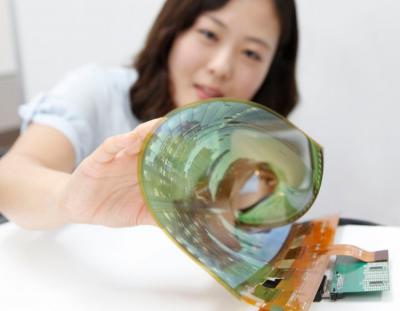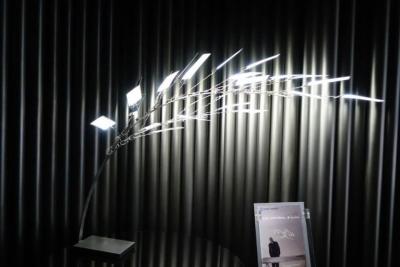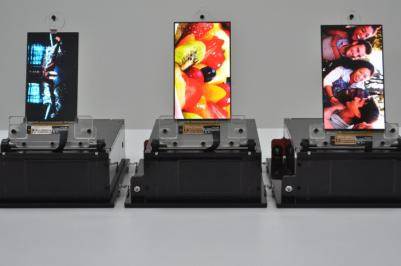 Several OLED markets are heating up - OLED TVs, Flexible OLEDs, wearables, OLED lighting, the automotive market... Barry Young from the OLED Association, one of the world's top OLED experts, was kind enough to offer his views and opinion on the OLED market.
Several OLED markets are heating up - OLED TVs, Flexible OLEDs, wearables, OLED lighting, the automotive market... Barry Young from the OLED Association, one of the world's top OLED experts, was kind enough to offer his views and opinion on the OLED market.
Q: What is your expectation from the OLED TV market in the next 1-3 years? Will LG be the only player (and if so what will be their capacity) or will Samsung and perhaps other enters the market too?
LG chose to implement the metal oxide/White OLED approach and has succeeded, where Samsung’s choice of LTPS/Small Mask Scanning (SMS) has proven too expensive to pursue even with ~80% yields.
Samsung has not given up; they are just going back to the R&D drawing board to come up with a more cost effective solution. LG now has 55, 65 and 77 AMOLED TVs with FHD and UHD resolution. When introduced, the OLED TVs were constrained by low volumes, low yields and the associated high costs. LG claims their yields have reached 80% from
We expect that LG’s mass production Gen 8.5 fab will come on line in 2015 and that capacity will reach an initial level of 1.5M to 1.8M displays per year. The high-end market will continue to be targeted until production costs drop to LCD levels.
Both Samsung and LG are looking seriously beyond VTE at IJP tools from Kateeva to solve the material utilization problem, but the issue of soluble material performance (primarily lifetime) still remains. To get a leg up, Samsung appears to be experimenting with the Kateeva tool for thin film encapsulation of flexible displays.
Q: Plastic-based flexible OLEDs are also starting to appear on the market for some application. How do you see this market developing in the next few years?
The plethora of smart watches and the use of flexible OLEDs because of their robustness, conformable form factor and low power consumption should provide the experience to move to more substantial applications. Samsung is well on its way to completing a 6th-gen fab dedicated to flexible displays so expect to see more conformable, rollable and even foldable displays enabling a wide range of new uses for displays.

Think about large conformable displays used to form the entire automotive console in colors that match the car’s interior replacing the entire current standard of fixed monitors and indicators. Think about displays that wrap around polls in retail or transportation environments or new types of hand held devices, where the display folds when not in use. Think about large TVs that you can carry home in a tube, which when unrolled hang on the wall like wallpaper. The opportunities are endless and the capabilities of flexible OLEDs will enable product designers to reach well beyond their current limitations.
Even Apple, whose CEO unfortunately labeled OLEDs as underperforming will likely be forced to recant his position, since his technical display staff chose OLEDs from LG Display for its new smart watch because of its unique form factor, robustness and low power consumption.
Moreover, one of OLEDs biggest critics has recently reported that the best smartphone display, the best phablet display and the best TV use OLED technology. We hope that Apple will now use its latent creativity to take advantage of the unique characteristics of OLEDs and move beyond simply increasing the size of its displays and calling it a new product.
Q: Many believe that the OLED lighting is also finally ready to emerge. Following the first mass-production attempts by Konica-Minolta, do you think that it's plausible to expect OLED lighting mass production in 2015 with down-to-earth prices?
It is quite misleading to speak generically of lighting prices, when there are so many different applications and luminaires that target wide ranges of performance and prices. Clearly, OLED are not going to compete with inorganic LEDs (LEDs) for lamp replacements of incandescent bulbs, the largest single market in terms of volume.

But why should it? Incandescent bulbs are point sources that must be covered to protect against glare and heat. OLED have very little glare or heat and are area sources of light more akin to the output of fluorescent bulbs with the noise, yellowing and mercury. OLEDs don’t need diffusers, optics, light guides and other support components typical of LEDs. If OLEDs were to replace an incandescent light source it would not be with a bulb but with a new luminaire without the shade.
OLED lighting must find its niche and initially it will be for specialty and architectural lighting where the form factor and the warmth of the light are given precedence. However, the OLED lighting industry has made remarkable progress over the last 2-3 years and companies such as LG Chemical are producing quality OLED panels at >100 lm/W with 3,000 cd/m2 luminance, CRI’s greater than 85 and lifetimes (L70) in the range of 30,000 to 40,000 hours; up from 50 lm/W, 1,000 cd/m2 and 20,000 hour lifetimes just 18 months ago.
The luminaire manufacturers have taken notice and we should start to see mass production products in the ten of thousands of units from the major luminaire manufacturers by 2015. And look out for Konica Minolta, which has produced >130 lm/W panels on its R-T-R line in Japan. They intend to commercialize large volumes of flexible lighting within the next two years.
Audi, the automotive supplier that introduced and commercialized the use of LED lighting has recently demonstrated a number of OLED lighting products, some in 3D. Expect OLEDs to enter this market with both Osram and Philips taking the lead but in the next 3-5 years.
Q: A few weeks ago we discussed the possibility of an OLED monitor or OLED laptop. It'll be interested to hear your views on why there isn't such a product on the market yet and when should we expect one?
I do not see much (any) upside to the notebook or monitor markets and displays are not being promoted as a differentiator. In the large display category, it is video where OLEDs outshine LCDs, so unless you are addressing cinematic monitors, I don’t think the OLED panel makers will spend much effort until OLED panel costs at these sizes are comparable to or less than LCDs.
Q: Encapsulation is one the challenges on the way to flexible OLEDs. There are several new technologies (such as several types of ALD, and UDC's UniversalBarrier) trying to enter the market. How wills this play out?
Thin film encapsulation is a critical element for flexible displays in terms of form factor, WVTR performance, cost and TACT. There are many solutions being proposed by a range of manufacturers, none of which has gained widespread use. It is likely that we will continue to see various solutions until the industry can coalesce on a solution, which currently ranges from some form of printing, to ALD, to frit to metal, to dyads of organic and inorganic layers and even simple layers of inorganic material.
I believe it is a little too early to predict the winner.
Q: Finally, we hear of several new companies that hope to start producing AMOLEDs commercially: AUO, JOLED, BOE, EDO, CSOT to name the most prominent ones. Are these companies really close to production, and how will this affect the AMOLED market?
The Chinese are jumping into this market because the OEMs in China for smartphones, TVs, tablets and other consumer products are demanding them. Samsung will be filling the void in the small/medium size and LG in TVs. The major Chinese panel suppliers, driven by the drive to be competitive and partially subsidized by the local and national governments are making a big push into technology.

Expect Tianma, CSOT, BOE and Visionox to be the first suppliers beginning in 2015. Each has funding for a gen 5.5 fab and larger. They will use LTPS and patterned RGB for smartphones and the LG approach for TVs. Visionox, due to its experience with full color PMOLEDs may have an early advantage but they are new the active matrix side of the equation.
Each of the companies are hedging their bets by starting out with a joint use LTPS fab for both OLEDs and LTPS. They hope to transfer all the capacity to OLEDs as the yields improve. There are at least 5 other panel makers in China that have announced their intent to enter the AMOLED market.
The Japanese have made a move by combining Japan Display with the OLED technology of Sony and Panasonic. I am not optimistic that this triumvirate will work but they do start with a strong technology position. Unfortunately, manufacturing displays in Japan has proven not be cost effective and unless there is some competitive advantage, i.e. KM’s R-T-R process for lighting, the new company will be hard pressed differentiate itself.
As for AUO, Samsung and the Chinese panel makers cited previously are filling the unfulfilled promises AUO made to Chinese OEMs. Further, AUO seems to be cash poor and are trying to compete with Gen-5.5 and Gen-6 fabs using an older Gen-4 fan in Singapore.
Thanks Barry for your time and insights. It seems to me that the next year or two will be exciting for the OLED industry!
Comments
The issue that this Barry Young didn't point out in regards to OLED monitors, is that most of the time a monitor is operational, the monitor has to deal with a lot of static content and elements. This is fine for LCD, but burn-in is still a huge issue for OLED. In the future burn-in will be less and less of an issue as the LEDs will of course improve, but we're far from that point. However I'm not saying that the industry doesn't need to produce monitor sized OLED panels. OLED monitors would be perfect for multimedia goals as you pointed out. And even more so for professionals. But for (wise) consumers, an OLED monitor would be a secondary display for the multimedia occasion, where the LCD (IPS) would still be the primary for the desktop and browser environments. And the consumer who feels that he can afford a secondary high-end monitor, is actually a real small segment in the total consumer market.
I wonder if it would be possible to make an oled monitor with lcd layer on top it? In desktop view, oled layer would be 100% white (no burn-in) and act as a backlight to the lcd, and when you would fire up a video, lcd layer would turn transparent and the picture would be made with the oled layer instead.
Seems like OLED in some form or other are the displays of the future! Regarding sunshine readable displays, what are the limitations on OLED brightness? Are they likely to be competition for E-paper, since there's no sign of this technology migrating to full colour.
OLEDs are getting better with direct sunlight, but they will never be as good as E-paper...


Regarding OLED monitors, I think there's huge opportunity here...
Personally I am waiting for a nice 24-30" OLED monitor to come out, and I'm sure I'm not the only one out there.
Similarly, many people watch movies from their laptops or tablets while lying in bed--I'm sure they would be interested.
There's also a large community made up of gamers who spend thousands on their gaming rig.. you really think these people won't be interested in an amazing OLED monitor either?
IMO this is a missed opportunity. But then again, I don't agree with numerous things, such as 'curved' televisions. Ironically they should focus on making curved monitors and flat televisions--that would make a lot more sense!